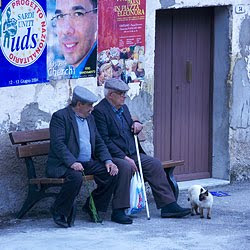I want you to come out with 4 different photos that we can look at on Wed. when you walk into class (psst...Remember that the compensation pics are due on Tues). You will have FOUR images that are completely DIFFERENT scenes.
We will take the advice of the post and use it for you to understand your ISO.
I want you to test your camera’s image quality at different ISO settings. Set your camera to AV (Aperture Priority). Set your aperture to no lower than 4. . . preferably around 5.6 the purpose of this assignment is not to mess with exposure, composition or depth of field. The goal is to test your camera’s ISO capacities and how it holds up under the pressure of high ISO’s. Step outside into the open shade. Shoot an image at 100 ISO and move up incrementally through your camera’s available ISO’s all the way until you reach your camera’s maximum ISO. . . don’t worry, your camera should make up for the extra sensitivity of the sensor by shortening the shutter speed. Upload the images and check the quality.
Friday, January 29, 2010
Thursday, January 28, 2010
ISO
This is a great explanation of ISO . As is this...
When choosing the ISO setting I generally ask myself the following four questions:
- Light – Is the subject well lit?
- Grain – Do I want a grainy shot or one without noise?
- Tripod – Am I use a tripod?
- Moving Subject – Is my subject moving or stationary?
If there is plenty of light, I want little grain, I’m using a tripod and my subject is stationary I will generally use a pretty low ISO rating.
White Balanced Photos
Please put your white balanced photos in a folder labeled with your name_wb (mooney_wb would be mine).
The files need to be renamed as jpegs and they need to be labeled with your name. Please post your favorite 3 on your blogs, with a short description of the image.
The files need to be renamed as jpegs and they need to be labeled with your name. Please post your favorite 3 on your blogs, with a short description of the image.
Exposure- due 2/1
How to get digital photography right ... its all about exposure!
Read the article and do 4 examples of the compensation. Be sure to note what your white balance is for each shot.
On Monday, I want you to have two photos that demonstrate this. (Your choice on what the photos are).
Read the article and do 4 examples of the compensation. Be sure to note what your white balance is for each shot.
On Monday, I want you to have two photos that demonstrate this. (Your choice on what the photos are).
Whatcha know about CS3? Due 2/4/10
We are all coming in with different strengths and weaknesses. Lets try out a montage to see where you are at with Photoshop. The size will be 8x10 with a resolution of 150.
The theme: PEOPLE'S PERCEPTION of YOU.
Choose one person in your life- how do they see you? Are you the picture of 'all things lovely' or are you 'rough around the edges'?
Please follow these guildelines:
- Use at least 8 layers, and the opacity must change in at least 3 layers
- Remember that "color" can have a meaning/tone. Pay attention to that as you select images.
- No words.
- You may not use any photographs of yourself.
- You may use stock images http://www.stockvault.net/ , http://pstutorialsblog.com/44/free-stock-photos/, http://www.freeimages.co.uk/ )
The theme: PEOPLE'S PERCEPTION of YOU.
Choose one person in your life- how do they see you? Are you the picture of 'all things lovely' or are you 'rough around the edges'?
Please follow these guildelines:
- Use at least 8 layers, and the opacity must change in at least 3 layers
- Remember that "color" can have a meaning/tone. Pay attention to that as you select images.
- No words.
- You may not use any photographs of yourself.
- You may use stock images http://www.stockvault.net/ , http://pstutorialsblog.com/44/free-stock-photos/, http://www.freeimages.co.uk/ )
Thursday, January 21, 2010
White Balance


We need to understand the technical aspects of photography before we worry about the content.
(The blue tint in the photo is done because the white balance is incorrect. The image on the right is correct.)
White balance is something that will instantly make your photos better.
Here is a tutorial on White Balance . This is another article that should help you become more familiar with white balance and all it entails.
For your first assignment (digital) I want you to take 10 photographs using different white balance settings. 10 Photos will be taken and we will project them on Friday. This will help us to understand where your skill base lies within photography as well. The photos need to be posted to your blog with descriptions about what you did to enhance them with white balance (full sentences).
Wednesday, January 20, 2010
27 Resources to Open Up a Whole New Photography 2.0 World
Ok, so you own a digital camera and you’ve taken more shots then you can count, and you’ve filled up more space on your hard drive than you have free.
You say you’re going to organize your files but you never quite get around to it, and you sure as hell never print out any images to put in an album or a frame.The problem: your beautiful, thought-provoking work sits on your computer and never sees the light of day. It never gets admired, wins awards, brings joy or breaks hearts. And this really is a problem!
The solution: take advantage of the amazing sites/resources that the latest version of the web has to offer and enter the world of photography 2.0.
What can you do in photography 2.0?
1. Share your images
The best thing about the web today is that it’s focused on connecting and sharing. And sharing is caring! By putting your work in the public domain, you can get feedback, inspiration and ideas. There are hundreds of image sharing sites out there. Some of the more popular ones are:2. Create a portfolio
If you want to be taken seriously as a photographer, you need to have a portfolio. Select your best images and showcase them through a portfolio site. A good idea is to share your images on one of the sites above and get some opinions on your work. Then, create your portfolio based on this feedback. Also, check out the portfolios of other photographers to see how they select and arrange their images. There are a plethora of portfolio building sites available, but the main ones are:3. Make a slideshow
Turn your images into a slideshow with music, transitions, titles and effects. Photomontage videos are an engaging, entertaining way of presenting your images. They help you stand out from the crowd and get your images seen. You can create a slideshow at:Then share it on:
4. Meet other photographers
Join a photography network and meet like-minded people. Share your experiences and learn from others – you might even make some new friends! Sign up to a photography specific network:Or connect with photographers on general social networks:
5. Get inspired
The best artists always have a keen awareness of the work of others in their field. After all, you can’t push the boundaries without knowing them first! There is endless inspiration on the web, but some great places to begin are:6. Start a blog
A blog let’s you bring all of this together. You can share your work (images and videos), your inspiration and your thoughts/ideas all in the one place. You can connect with other photographers by commenting on their blogs and by adding them to your blogroll, and you can join photography blogging communities. Check out these sites to get started:Sunday, January 17, 2010
Blog name
- When signing in with your name please use the naming convention of:
OHS.firstname.Lastinital.Dayofbirth
ex: OHSJoeS27
- Keep in mind that this blog is for educational purposes. Keep comments directed towards digital photography, as well as details about your life.
OHS.firstname.Lastinital.Dayofbirth
ex: OHSJoeS27
- Keep in mind that this blog is for educational purposes. Keep comments directed towards digital photography, as well as details about your life.
Subscribe to:
Comments (Atom)

